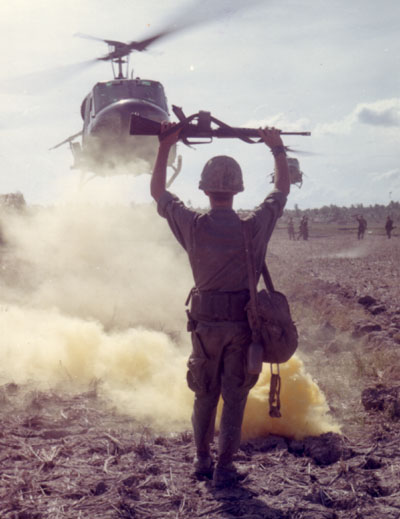The First Team in the ‘Nam
“We’re Still Cavalry!â€
Upon arriving in Vietnam in the fall of 1965, the proud young sky troopers of the 1st Cavalry Division (Airmobile) took a lot of ribbing from the grunts. They ridiculed their “cruising†around in the sky, enjoying a soft army life. In angry defense, a young private, embarrassed, yet intensely proud of his unit and his accomplishments, retorted, “Go to hell! We’re still cavalry!â€
And they were. It is true that their arrival on the battlefields of Southeast Asia was not heralded by a trumpet sounding “charge,†or the thundering hooves of frothing stallions, but rather the whirring of jet turbine engines and the steady “thump-thump,†unique sound of swirling Huey helicopter rotor blades. They carried no sabers, but instead, automatic weapons. Their cannons were not pulled by draft horses, but also mounted on helicopters; lethal, fast moving gunships, darting in and out of enemy positions, leaving a trail of death.
{default}
Keeping the Tradition
At first glance, they looked just like any other foot soldier, but they were far different. They brought with them the tradition of American cavalry. This element of the United States Army had been the glory of its armed forces. They walked and fought with a unique flair. They were part of a noble and proud tradition.
It was during the Civil War that the American cavalry came into its own. The dash and wiliness of imaginative cavalry leaders revealed the potential of this vital military arm. Names like Stuart, Custer, Sheridan and Forrest became as familiar as Grant and Lee.
They were independent formations, designed to move fast. Their purpose was to scout and reconnoiter. They were equally capable of executing lightning attacks or strong delaying actions. They covered the flanks and became the eyes of large armies of foot soldiers as they marched.
One of the most potent capabilities of these mounted fighters was the cavalry raid. They overran enemy outposts, disrupted lines of communication and played havoc with supply lines. The enemy had to always wonder if enemy horsemen were around. The threat alone was electric.
During the Indian wars, the Cavalry was in its glory. It was the horse soldier that helped to win and control the west. Once, however, the era had passed, cavalry fell into a quieter, more nondescript role of courier service and fighting as dismounted infantry.
The Need for Cavalry
With the advent of the mechanized age, cavalry was seen in a new light. Here was the opportunity to form strong, fast-moving forces that could again do the job of the cavalry of the nineteenth century. During the Second World War, cavalry squadrons performed nobly and contributed to many victories.
At the initiation of the “Great War,†most nations went to the division as the basic military unit. Smaller cavalry suddenly found itself in a vacuum, now that the horse had little or no place on the modern battlefield. New doctrines premised on light mechanized reconnaissance began to be developed and in the interim most cavalry units tried to fit the new role or else simply reverted to foot infantry.

But die-hard military men would not allow the concept to just disappear. Cavalry still had a role, but it was vague. Then the First Cavalry Division was organized at Fort Bliss in 1941. It remained largely horse cavalry until ordered overseas in 1943. Then the changeover from horse to jeep or armored car began. Since it was intended for amphibious assault in the Pacific, it was changed with special equipment allowances and retrained as infantry. By the end of the war, the 1st Cav had become a pure infantry formation. The only part of it that was still cavalry was its name.
There were numerous cavalry units smaller in size that performed well during the Second World War, but many seemed uncertain as to the role it should play. Some felt it was that of armor, while others felt that there was something else out there for these rapid-deployment forces. The question was how to apply the basic cavalry doctrines of scouting and rapid raids to modern times.
In Korea, the tragedy of a lack of the cavalry element in an army became apparent. Early in the war, a perfect opportunity for flanking the North Koreans as they squeezed American forces into a corner presented itself, but the 1st Cav did not have the wherewithal to take advantage of it. There was no unit so equipped and trained in the military inventory of the UN forces deployed in Korea.
Later, after the successful invasion of Inchon, the 8th Army, still not fully mechanized and without strong mobile formations found itself putting together “task forces,†or mixed units of tanks and infantry in an effort to catch up with and cut off the fleeing North Korean army. Instead, except for a few successful efforts, such as TF Dolvin, the US Army was slow on the move.
But it was the great tragedy of the sudden Chinese intervention that underlined the need for specialized and properly equipped units prepared as cavalry. Air surveillance was not enough. The Chinese “volunteers,†nearly half a million strong moved into North Korea and remained largely undetected.
Roving cavalry units, had they existed, might have discovered the seriousness of the situation before disaster struck. The sudden Chinese human avalanche against UN forces sent them reeling southward in panic and confusion.
[continued on next page]

